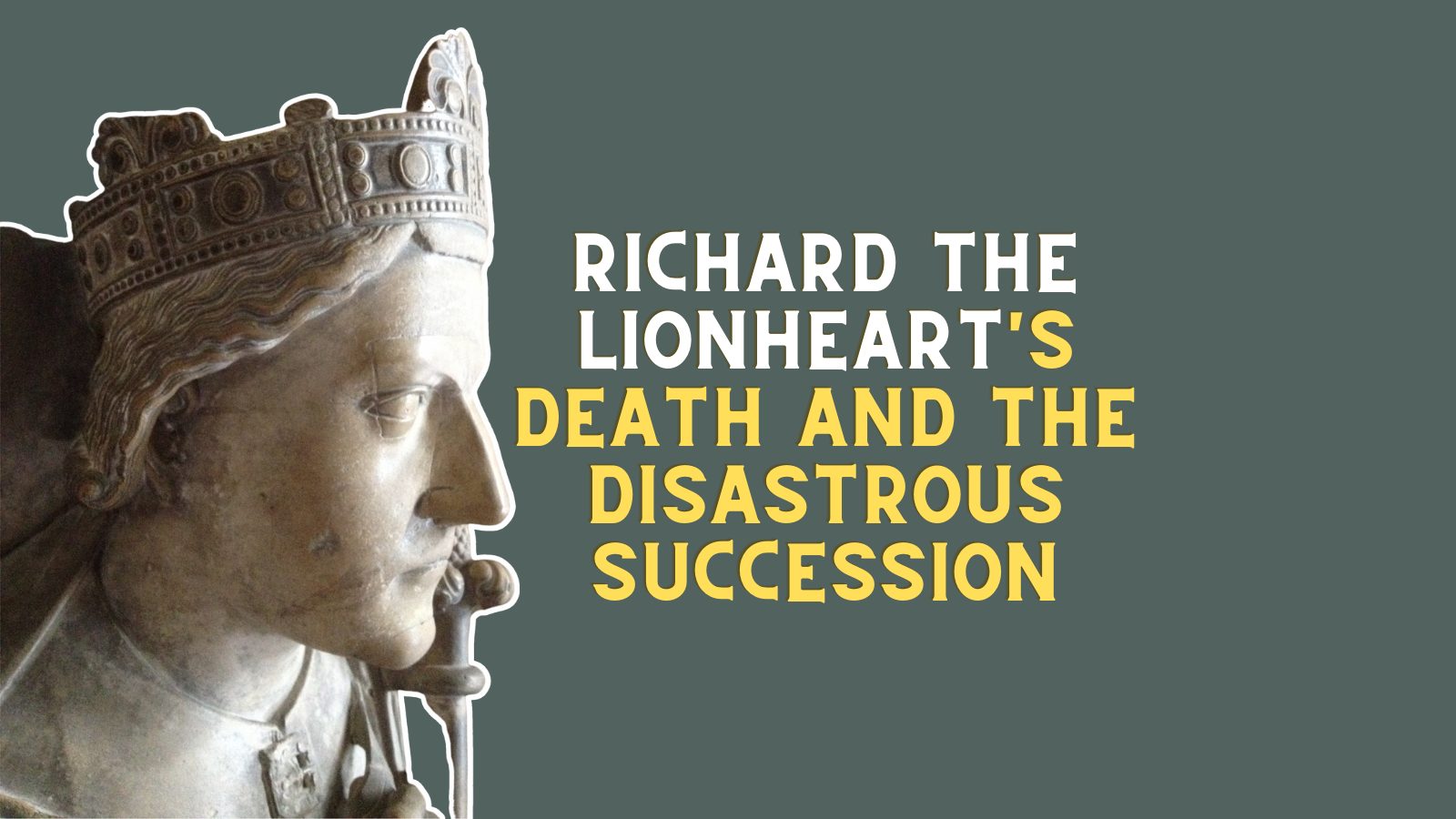Richard the Lionheart’s death and the disastrous succession
King Richard I of England, better known as ‘Richard the Lionheart,’ was a talented military leader and tactician who achieved fame in the Holy Land during the Third Crusade in the 12th century. He fought against the great Muslim leader Saladin, but he developed a reputation for extreme savagery despite victories.
His 10-year reign, which began in 1189 and concluded with his death in 1199, is well known for the time spent outside of the country on various military campaigns. During his absence from the country, his mother, Elenor of Aquitaine and William de Longchamp effectively acted as Regents. In fact, Richard only spent around a year in the country while he was King. His choice of regents caused problems with his younger brother John. He believed that he should be the one running the country in his brother’s absence.
There was further criticism when Richard the Lionheart was captured by Leopold of Austria in 1192 and handed over to the Holy Roman emperor, Henry VI. The sum of 150,000 marks was demanded for his release. His mother made attempts to raise the money with taxes. People objected as to why they should pay for a King who was never there. Interestingly his brother John offered money to keep Richard a prisoner.
It is safe to safe that there wasn’t a great deal of brotherly love between the two.
Of course, Richard’s unexpected death resulted in John succeeding to the throne.
The castle of Châlus, which held rebels opposed to his reign, was surrounded by Richard when a crossbow shot from the walls above entered his left shoulder. Despite the fact that the wound was first considered small, gangrene developed, and Richard died on April 6th 1199. He was in his mother’s arms when he died.
[/et_pb_text][/et_pb_column][/et_pb_row][et_pb_row _builder_version=”4.15.0″ _module_preset=”default” global_colors_info=”{}”][et_pb_column type=”4_4″ _builder_version=”4.15.0″ _module_preset=”default” global_colors_info=”{}”][et_pb_text _builder_version=”4.15.0″ _module_preset=”default” global_colors_info=”{}”]The man who should never have been King
[/et_pb_text][/et_pb_column][/et_pb_row][et_pb_row _builder_version=”4.15.0″ _module_preset=”default” column_structure=”1_5,3_5,1_5″][et_pb_column _builder_version=”4.15.0″ _module_preset=”default” type=”1_5″][/et_pb_column][et_pb_column _builder_version=”4.15.0″ _module_preset=”default” type=”3_5″][et_pb_image src=”http://historywithhenry.com/wp-content/uploads/2022/04/Seal_-_Richard_I_of_England-scaled.jpg” _builder_version=”4.15.0″ _module_preset=”default” alt=”Richard the Lionheart’s Death” title_text=”Seal_-_Richard_I_of_England” hover_enabled=”0″ sticky_enabled=”0″ align=”center” width=”93%”][/et_pb_image][/et_pb_column][et_pb_column _builder_version=”4.15.0″ _module_preset=”default” type=”1_5″][/et_pb_column][/et_pb_row][et_pb_row _builder_version=”4.15.0″ _module_preset=”default” global_colors_info=”{}”][et_pb_column type=”4_4″ _builder_version=”4.15.0″ _module_preset=”default” global_colors_info=”{}”][et_pb_text _builder_version=”4.15.0″ _module_preset=”default” global_colors_info=”{}”]As the third son of Henry II and Eleanor of Aquitaine, Richard was never destined to be King of England.
For much of Richard’s early life, family tensions were rife…and at this stage, they didn’t even include John.
Richard instigated rebellions against his father on a regular basis from 1173 onward. His father held his mother prisoner. And then, his two eldest brothers ended up fighting against him.
Henry II died in July 1189 at the age of 56. Richard’s elder brothers had died before him, leaving Richard the throne.
When Richard was crowned King, he moved quickly to make preparations to amass cash in order to embark on a crusade to the Holy Land.
By the time he returned, his Kingdom was in turmoil.
[/et_pb_text][/et_pb_column][/et_pb_row][et_pb_row _builder_version=”4.15.0″ _module_preset=”default” global_colors_info=”{}”][et_pb_column type=”4_4″ _builder_version=”4.15.0″ _module_preset=”default” global_colors_info=”{}”][et_pb_text _builder_version=”4.15.0″ _module_preset=”default” global_colors_info=”{}”]John was at the centre of the problem
[/et_pb_text][/et_pb_column][/et_pb_row][et_pb_row _builder_version=”4.15.0″ _module_preset=”default” column_structure=”1_5,3_5,1_5″][et_pb_column _builder_version=”4.15.0″ _module_preset=”default” type=”1_5″][/et_pb_column][et_pb_column _builder_version=”4.15.0″ _module_preset=”default” type=”3_5″][et_pb_image src=”http://historywithhenry.com/wp-content/uploads/2022/04/Jan_tomb.jpg” _builder_version=”4.15.0″ _module_preset=”default” alt=”Richard the Lionheart’s Death” title_text=”Jan_tomb” align=”center” width=”45%” hover_enabled=”0″ sticky_enabled=”0″][/et_pb_image][/et_pb_column][et_pb_column _builder_version=”4.15.0″ _module_preset=”default” type=”1_5″][/et_pb_column][/et_pb_row][et_pb_row _builder_version=”4.15.0″ _module_preset=”default” global_colors_info=”{}”][et_pb_column type=”4_4″ _builder_version=”4.15.0″ _module_preset=”default” global_colors_info=”{}”][et_pb_text _builder_version=”4.15.0″ _module_preset=”default” global_colors_info=”{}”]Richard and his mother returned home after his release by the Holy Roman Emporer.
Initially, his imprisonment was relatively easy. However, the conditions got more severe until he was tied up in chains heavier than him.
On his arrival in England, Richard went immediately to the shrine of St Thomas Becket in Canterbury to express his gratitude for his homecoming and then set about dealing with the resistance that had risen while he had been away.
It seemed that his brother John was at the centre of the problems.
While at Nottingham, Richard spent time restoring order, which included a trip to Sherwood Forest, a location that would come to be strongly connected with him due to his role in the Robin Hood legend. Do you remember him popping up in numerous Robin Hood adaptations?
But John was yet to be tackled.
The King and Eleanor embarked on a voyage from Portsmouth to Barfleur in Normandy on April 24, 1194. The fact it was their last visit to England was something neither of them could have anticipated. When they arrived at Lisieux, John came and flung himself at the mercy of Richard. Perhaps as a result of their mother’s influence, Richard forgave his younger brother.
[/et_pb_text][/et_pb_column][/et_pb_row][et_pb_row _builder_version=”4.15.0″ _module_preset=”default” global_colors_info=”{}”][et_pb_column type=”4_4″ _builder_version=”4.15.0″ _module_preset=”default” global_colors_info=”{}”][et_pb_text _builder_version=”4.15.0″ _module_preset=”default” global_colors_info=”{}”]Tackling France and a bolt from the blue
[/et_pb_text][/et_pb_column][/et_pb_row][et_pb_row _builder_version=”4.15.0″ _module_preset=”default” column_structure=”1_5,3_5,1_5″][et_pb_column _builder_version=”4.15.0″ _module_preset=”default” type=”1_5″][/et_pb_column][et_pb_column _builder_version=”4.15.0″ _module_preset=”default” type=”3_5″][et_pb_image src=”http://historywithhenry.com/wp-content/uploads/2022/04/Lvisrdce.jpg” _builder_version=”4.15.0″ _module_preset=”default” alt=”Richard the Lionheart’s Death” title_text=”Lvisrdce” align=”center” width=”50%” hover_enabled=”0″ sticky_enabled=”0″][/et_pb_image][/et_pb_column][et_pb_column _builder_version=”4.15.0″ _module_preset=”default” type=”1_5″][/et_pb_column][/et_pb_row][et_pb_row _builder_version=”4.15.0″ _module_preset=”default” global_colors_info=”{}”][et_pb_column type=”4_4″ _builder_version=”4.15.0″ _module_preset=”default” global_colors_info=”{}”][et_pb_text _builder_version=”4.15.0″ _module_preset=”default” global_colors_info=”{}”]Over the years that followed, Richard set about reclaiming the estates that Philip II of France had appropriated while he was away. As a crusader, Richard’s territories should have been safeguarded by the Pope. But Philip had found the opportunity there, and the Pope had done nothing to prevent him from taking advantage of the situation.
Richard was in the Limousin area of Aquitaine in March 1199 as part of his ongoing efforts to retake control of the province from Philip. Richard travelled to the region to restore order, eventually settling down to lay siege to the Aimar V, Count’s fortress of Limoges at Châlus.
The King that had fought in so many campaigns was about to get a shock.
Richard was enjoying a leisurely stroll around the borders of Châlus on the 6th of March, 1199. He was checking the defences of Châlus with his leaders. A crossbow shot fired from the walls struck the King in the shoulder, causing him to fall to the ground. At first glance, the damage didn’t appear to be very serious. Richard was given some medical attention, and it was assumed that all was well.
Several days later, it became evident that the wound was significantly more severe than had been originally believed. Eventually, it grew infected and became black, which was an obvious indicator that gangrene had taken hold. Richard realised he was on the verge of death because amputation was impossible because the wound was not on an extremity.
[/et_pb_text][/et_pb_column][/et_pb_row][et_pb_row _builder_version=”4.15.0″ _module_preset=”default” global_colors_info=”{}”][et_pb_column type=”4_4″ _builder_version=”4.15.0″ _module_preset=”default” global_colors_info=”{}”][et_pb_text _builder_version=”4.15.0″ _module_preset=”default” global_colors_info=”{}”]The Strange Death of Richard the Lionheart
[/et_pb_text][/et_pb_column][/et_pb_row][et_pb_row _builder_version=”4.15.0″ _module_preset=”default” column_structure=”1_5,3_5,1_5″][et_pb_column _builder_version=”4.15.0″ _module_preset=”default” type=”1_5″][/et_pb_column][et_pb_column _builder_version=”4.15.0″ _module_preset=”default” type=”3_5″][et_pb_image src=”http://historywithhenry.com/wp-content/uploads/2022/04/Richard1Rouen.jpg” _builder_version=”4.15.0″ _module_preset=”default” alt=”Richard the Lionheart’s Death” title_text=”OLYMPUS DIGITAL CAMERA” hover_enabled=”0″ sticky_enabled=”0″][/et_pb_image][/et_pb_column][et_pb_column _builder_version=”4.15.0″ _module_preset=”default” type=”1_5″][/et_pb_column][/et_pb_row][et_pb_row _builder_version=”4.15.0″ _module_preset=”default” global_colors_info=”{}”][et_pb_column type=”4_4″ _builder_version=”4.15.0″ _module_preset=”default” global_colors_info=”{}”][et_pb_text _builder_version=”4.15.0″ _module_preset=”default” global_colors_info=”{}”]Recognising that he had only a limited amount of time left, Richard sent a message to his mother, who lived nearby at Fontevraud Abbey. Eleanor dashed to her son. She cradled him in her arms as he died.
The man who had shot the crossbow had turned out to be nothing more than a boy. Various historical sources give him multiple names. Richard pardoned the boy on his deathbed. However, after the King’s death, Richard’s commander, Mercadier, sought the boy out. He was executed by flaying (Having the skin peeled from his body while still alive) and hanging.
Richard’s body was disembowelled, as was customary in the period. But the arrangements for his burial were unusual.
His entrails were interred in Châlus, the site of his death.
He requested that his heart be brought to Rouen Cathedral and interred next to the grave of his brother, Henry the Young King.
He gave orders that his body is placed to rest in Fontevraud Abbey, at the feet of his father. It was a final gesture of remorse on the part of a son who, possibly for the first time, realised the difficulties his father had suffered, and which he had exacerbated.
His tomb can still be seen today, together with that of his father and Eleanor of Aquitaine.
[/et_pb_text][/et_pb_column][/et_pb_row][et_pb_row _builder_version=”4.15.0″ _module_preset=”default” global_colors_info=”{}”][et_pb_column type=”4_4″ _builder_version=”4.15.0″ _module_preset=”default” global_colors_info=”{}”][et_pb_text _builder_version=”4.15.0″ _module_preset=”default” global_colors_info=”{}”]The succession
[/et_pb_text][/et_pb_column][/et_pb_row][et_pb_row _builder_version=”4.15.0″ _module_preset=”default” column_structure=”1_5,3_5,1_5″][et_pb_column _builder_version=”4.15.0″ _module_preset=”default” type=”1_5″][/et_pb_column][et_pb_column _builder_version=”4.15.0″ _module_preset=”default” type=”3_5″][et_pb_image src=”http://historywithhenry.com/wp-content/uploads/2022/04/John_of_England_John_Lackland.jpg” _builder_version=”4.15.0″ _module_preset=”default” alt=”Richard the Lionheart’s Death” title_text=”John_of_England_(John_Lackland)” hover_enabled=”0″ sticky_enabled=”0″ align=”center” width=”60%”][/et_pb_image][/et_pb_column][et_pb_column _builder_version=”4.15.0″ _module_preset=”default” type=”1_5″][/et_pb_column][/et_pb_row][et_pb_row _builder_version=”4.15.0″ _module_preset=”default” global_colors_info=”{}”][et_pb_column type=”4_4″ _builder_version=”4.15.0″ _module_preset=”default” global_colors_info=”{}”][et_pb_text _builder_version=”4.15.0″ _module_preset=”default” global_colors_info=”{}”]Richard died childless, complicating the succession.
Using today’s rules, Arthur I, Duke of Brittany, should have succeeded. He was Richard’s nephew, the son of his long-dead brother Geoffrey. However, John, Richard’s youngest brother, took over as Richard’s successor. Arthur was just a young teenager, whereas John was a man. John was in England; Arthur was not. It was easy for John to claim the crown.
Arthur rose up against John’s land in France. However, in July 1202, he was captured by King John and imprisoned.
John ordered the blinding and castration of his nephew to ensure he would no longer be a threat. However, his jailor refused to do so, instead, he told John the boy had died of natural causes.
We know he was moved to Rouen a year later, but then all records of him stop.
Some accounts say that John killed him personally and then threw his body in the Seine. We will never know.
John was widely regarded as one of the worst monarchs in British history, and the succession was disastrous. He was responsible for the loss of all of the country’s continental possessions, with the exception of Gascony. The Barons revolted against his rule, which resulted in the signing of the Magna Carta.
Perhaps this disastrous succession would not have occurred if Richard the Lionheart had spent more time tending to matters in England.
[/et_pb_text][/et_pb_column][/et_pb_row][/et_pb_section]





